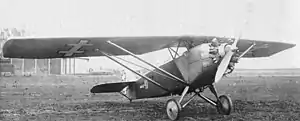ANBO III
The ANBO III was a parasol-wing monoplane training and utility aircraft designed for the Lithuanian Army in 1929. It became the first aircraft of Lithuanian design to be built in series, with two batches of four aircraft produced in 1930 and 1931. The ANBO IIIs also saw service as reconnaissance machines.[1]
| ANBO III | |
|---|---|
 | |
| ANBO III with Walter Mars engine | |
| Role | Military advanced trainer aircraft |
| Manufacturer | Karo Aviacijos Tiekimo Skyrius |
| Designer | Antanas Gustaitis |
| First flight | 1929 |
| Number built | 9 |
| Developed from | ANBO II |
| Developed into | ANBO IV |
Development
In early 1931 the ANBO III was flying with a 108 kW (145 hp) Walter Mars I, a nine-cylinder radial engine[2][3] but production aircraft were powered by Armstrong Siddeley Genet Major radials.[1]
Specifications (Walter Mars I engine)
Data from Les Ailes April 1931[2]
General characteristics
- Crew: Two
- Length: 6.90 m (22 ft 8 in)
- Wingspan: 10.55 m (34 ft 7 in)
- Height: 2.64 m (8 ft 8 in)
- Wing area: 18.20 m2 (195.9 sq ft)
- Empty weight: 580 kg (1,279 lb)
- Gross weight: 880 kg (1,940 lb)
- Powerplant: 1 × Walter Mars I 9-cylinder radial, 108 kW (145 hp) at 1,800 rpm
- Propellers: 2-bladed
Performance
- Maximum speed: 185 km/h (115 mph, 100 kn) at ground level
- Endurance: 4 hr
- Service ceiling: 4,800 m (15,700 ft) service
- Time to altitude: 12 min to 2,000 m (6,600 ft)
References
| Wikimedia Commons has media related to ANBO III. |
- "ANBO III". Archived from the original on 27 September 2007. Retrieved 7 November 2016.
- "Le monoplan Gustaitis "Anbo III"". Les Ailes (in French) (512): 3. 9 April 1931.
- "Czechoslovakia". Flight. XXI (30): 762. 4 March 1965.
Further reading
- Taylor, Michael J. H. (1989). Jane's Encyclopedia of Aviation. London: Studio Editions.
This article is issued from Wikipedia. The text is licensed under Creative Commons - Attribution - Sharealike. Additional terms may apply for the media files.